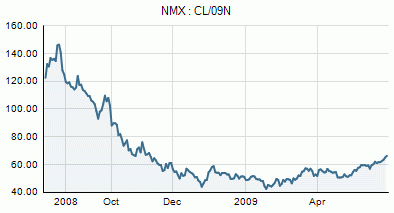

Energy supply crunch brewing
By Deborah Yedlin
Calgary Herald
May 28, 2009
 Brent Light Sweet Crude 12 month to May 2009 |
Forget low oil prices. The worry of the moment is a spike in oil prices and how long it will take before a supply crunch sends prices soaring.
And if one subscribes to the views of former CIBC World Markets economist Jeff Rubin and University of California, San Diego economics professor James Hamilton, a spike in prices could send the world tumbling back into recessionary territory, just as it is about to climb out of it.
Both Rubin and Hamilton hold the view that the current recession is the result of a spike in oil prices and not the collapse in the U. S. housing market.
So what's the deal with the about-face in sentiment on oil prices?
It doesn't get much simpler than the basic economic principles of supply and demand.
Ever since the bottom dropped out of the economy -- and the oil market -- last fall, there has been a single-minded focus on the weekly demand numbers released by the various energy agencies around the world. The conclusion drawn was that oil prices were going to remain weak for the foreseeable future because of the huge drop in consumption.
This, despite other compelling information that has long determined the decline rates of existing fields, even with steady demand, is going to push the world toward an oil shortage.
Now, all of a sudden, the tide has turned and the focus is on the supply side.
What's interesting is the mix of organizations on the supply-shortage bandwagon.
In recent weeks, the International Energy Agency has weighed in on the subject, saying in a recent report the lack of investment by countries that are not members of the Organization of Petroleum Exporting Countries has cost the world two million barrels a day. Of this, 1.7 million barrels are related to the slowdown in the development of Alberta's oilsands.
But the IEA doesn't stop there. It goes on to say an additional 4.2 million barrels a day have been put on hold for at least 18 months as a result of the drop in capital expenditures.
Moreover, the drop in production could be even higher if national oil companies -- whose agendas often lie outside their control -- see dollars diverted to other government priorities and away from energy-related activities.
The IEA also points out the lag between investment decisions and the time it takes to bring production on stream.
Reading between the lines, the IEA is suggesting companies and countries need to be investing in new production, even as prices have slumped.
"There is a real danger that sustained lower investment in supply in the coming months and years could lead to a shortage of capacity and another spike in energy prices in several years' time, when the economy is on the road to recovery."
And if the recovery happens faster than some expect, the shortage could manifest itself sooner rather than later.
The IEA has company in the form of OPEC, which called for increased levels of investment following a meeting of the G-8 ministers in Rome. Its position is simply that without investment, prices are headed back to the $150 US per barrel level within the three years.
While OPEC might be right on this, the hypocrisy of this statement is glaring. It's no secret OPEC members aren't exactly known for reinvesting their petrodollars looking for oil and natural gas reserves; the modus operandi in that part of the world has more to do with subsidizing political agendas--primarily keeping gasoline prices dirt cheap--than it does with finding new sources of hydrocarbons or investing in social infrastructure such as schools and health care.
To this can be added the views of the International Monetary Fund and investment firm Merrill Lynch, both of which are warning of the consequences of a lack of investment and the impact of prices above $70 per barrel on the economies of the Organization for Economic Co-operation and Development.
Consulting firm McKinsey &Co. also weighed in with its analysis this week, which showed supplies could begin to tighten as early as next year, even if economic growth is on the weak side.
All this should make Albertans happy. A higher oil price is good for the economy--though not as good as higher natural gas prices --and there is the distinct possibility that if prices stabilize in the $60 range, the oilsands projects that were put on hold might be put back on the active roster.
What's surprising is that not everyone looks at this as being good news. A number of players on the investment side of the business --whether buy-side (investors) or sell-side (investment firms) --believe the sector needs to go through what is being seen as a period of cleansing;a higher oil price will effectively negate this process, which is now underway. It's not unlike forests regenerating after a fire.
The reasoning goes something like this: times like these season management teams and teach the valuable lesson that everyone looks like a hero when times are good. But it's the challenging times that mint the next generation of individuals who learn from the lessons of a downturn and apply them to the problems of the future. Look no further than the demise of Dome Petroleum-- and the experience that has been put to good use these past few months--for evidence of this.
Of course, no one really knows where oil prices are headed long term, but it's getting harder to ignore the growing body of analysis pointing to a supply crunch as a result of the 15 per cent drop in investment and continued declines in the big fields around the world.
The smart money looks like it's on prices going up, not down.
© Copyright (c) The Calgary Herald
Posted by Arthur Caldicott on 30 May 2009